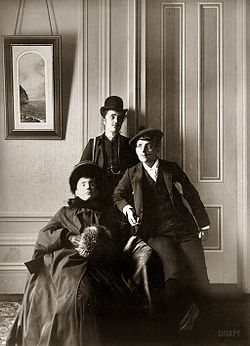- Cross-dressing
-
 The American photographer and photojournalist Frances Benjamin Johnston (right) cross-dressing in a portrait with two friends.
The American photographer and photojournalist Frances Benjamin Johnston (right) cross-dressing in a portrait with two friends.
Cross-dressing History of cross-dressing Breeches role · Breeching
Travesti · In film and television
In wartime · Pantomime dameKey elements As a transgender identity
Passing · TransvestismModern drag culture Ball culture · Drag
Drag king · Drag pageantry
Drag queen · Faux queen
List of drag queensSexual aspects Autoandrophilia · Autogynephilia
Feminization · Pinafore eroticism
Transvestic fetishism
Sissy · Transgender sexualitySexual attraction
to cross-dressersAndromimetophilia
GynemimetophiliaOther aspects Bacha posh · Crossplay
En femme
Female masking
Girlfag and guydyke
Gender disguisePassing as male Breast binding · Packing Passing as female Cleavage enhancement
Hip and buttock paddingOrganizations Tri-Ess Books My Husband Betty
She's Not The Man I MarriedCross-dressing is the wearing of clothing and other accoutrement commonly associated with a gender within a particular society that is seen as different than the one usually presented by the dresser.[1] Cross-dressing has been used for disguise, performance art and as a literary trope in modern times and throughout history.
Nearly every human society throughout history has made distinctions between male and female gender by the style, color, or type of clothing they are expected to wear, and likewise most societies have had a set of norms, views, guidelines, or even laws defining what type of clothing is appropriate for each gender. Cross-dressing runs significantly counter to those norms and, therefore, can be seen as a type of transgender behavior.[citation needed] It does not, however, necessarily indicate transgender identity; a person who cross-dresses does not always identify as being of a gender other than their assigned gender.
The term cross-dressing denotes an action or a behavior without attributing or proposing causes for that behavior. Some people automatically connect cross-dressing behavior to transgender identity or sexual, fetishist, and homosexual behavior, but the term cross-dressing itself does not imply any motives.
Contents
History of crossdressing
Main article: History of crossdressingCrossdressing has existed throughout much of recorded history. There are many examples in Greek, Norse, and Hindu mythology. A reasonable number of historical figures are known to have crossdressed to varying degrees and for a variety of reasons. There is a rich history of crossdressing found in folklore, literature, theater, and music.
Varieties of cross-dressing
There are many different kinds of cross-dressing and many different reasons why an individual might engage in cross-dressing behaviour.[2] Some people cross-dress as a matter of comfort or style. They may prefer clothing associated with the opposite sex. In this case, a person's cross-dressing may or may not be apparent to other people. Some people cross-dress to shock others or challenge social norms.
Both men and women may cross-dress to disguise their physical sex. Historically, some women have cross-dressed to take up male-dominated or male-exclusive professions, such as military service. Conversely, some men have cross-dressed to escape from mandatory military service[3] or as a disguise to assist in political or social protest, as men did in the Rebecca Riots.
Single-sex theatrical troupes often have some performers cross-dress to play roles written for members of the opposite sex. Cross-dressing, particularly the depiction of males wearing dresses, is often used for comic effect onstage and onscreen.
Drag is a special form of performance art based on cross-dressing. A drag queen is usually a male-bodied person who performs as an exaggeratedly feminine character, in heightened costuming sometimes consisting of a showy dress, high-heeled shoes, obvious makeup, and wig. A drag queen may imitate famous female film or pop-music stars. A faux queen is a female-bodied person employing the same techniques.
A drag king is a counterpart of the drag queen but usually for much different audiences. A female-bodied person who adopt a masculine persona in performance or imitates a male film or pop-music star. Some female-bodied people undergoing gender reassignment therapy also self-identify as drag kings although this use of "drag king" would generally be considered inaccurate.
Transgender people who are undergoing or have undergone gender reassignment therapy are usually not regarded as cross-dressing. Namely, a transsexual who has completed gender reassignment surgery is certainly not considered cross-dressing, unless they were to wear clothes of the gender opposite of what they have transitioned to. Pre-operative transsexuals may be considered similarly.
A transvestic fetishist is a person (typically a heterosexual male) who cross-dresses as part of a sexual fetish.
The term underdressing is used by male cross-dressers to describe wearing female undergarments under their male clothes. The famous low-budget filmmaker Edward D. Wood, Jr. said he often wore women's underwear under his military uniform during World War II.
Some people who cross-dress may endeavor to project a complete impression of belonging to another gender, down to mannerisms, speech patterns, and emulation of sexual characteristics. This is referred to as passing or "trying to pass" depending how successful the person is. An observer who sees through the cross-dresser's attempt to pass is said to have read or clocked them. There are videos, books, and magazines on how a man may look more like a woman.[4]
Sometimes either person of a heterosexual couple will wear it to arouse the other. For example, the male would wear skirts or lingerie and/or the female will wear boxers or other male clothing. (See also forced feminization)
Others may choose to take a mixed approach, adopting some feminine traits and some masculine traits in their appearance. For instance, a man might wear both a dress and a beard. This is sometimes known as genderfuck.
Utilitarian purposes also bring about forms of crossdressing, such as support hose for men with bad circulation in their legs, or the wearing of bras for men with gynecomastia (male breasts).
Clothes
The actual determination of cross-dressing is largely socially constructed. For example, in Western society, trousers have been adopted for wear by women, and is not regarded as cross-dressing. In cultures where men have traditionally worn skirt-like garments such as the kilt or sarong these are not seen as female clothing, and wearing them is not seen as cross-dressing for men. As societies are becoming more global in nature, both men and women are adopting styles of dress associated with other cultures.
It was once taboo in Western society for women to wear clothes traditionally associated with men, excepting certain circumstances, such as for necessity (as per St. Thomas Aquinas's guidelines in Summa Theologiae II)[5]
While this prohibition remained in force in general throughout the middle and early modern ages, this is no longer the case and Western women are often seen wearing trousers, ties, and men's hats. Nevertheless, many cultures around the world still prohibit women from wearing trousers or other traditionally male clothing.[citation needed]
Cosplaying may also involve cross-dressing, for some females may wish to dress as a male, and vice versa (see Crossplay). Breast binding (for females) is not uncommon and is most likely needed to cosplay a male character.
In most parts of the world it remains socially frowned upon for men to wear clothes traditionally associated with women. Attempts are occasionally made, e.g. by fashion designers, to promote the acceptance of skirts as everyday wear for men. Cross-dressers have complained that society permits women to wear pants or jeans and other masculine clothing, while condemning any man who wants to wear clothing sold for women.
While most male cross-dressers utilize clothing associated with modern women, there are some who are involved in subcultures that involve dressing as little girls or in vintage clothing. Some such men have written that they enjoy dressing as feminine as possible, so they will wear frilly dresses with lace and ribbons, as well as multiple petticoats, corsets, girdles and/or garter belts with nylon stockings.[6]
Social issues
Cross-dressers may begin wearing their opposite sex's clothing as children, using the clothes of a sibling, parent, or friend. Some parents have said they allowed their children to cross-dress and, in many cases, the child stopped when they became older. The same pattern often continues into adulthood, where there may be confrontations with a spouse. Married cross-dressers experience considerable anxiety and guilt if their spouse objects to their behaviour. Some cross-dressers have periodically disposed of all their clothing, a practice called "purging", only to start another collection later.[2]
Analyses
The historical associations of maleness with power and femaleness with submission and frivolity mean that in the present time a woman dressing in men's clothing and a man dressing in women's clothing evoke very different responses. A woman dressing in men's clothing is a marginally more acceptable activity. Feminist advocacy for social change has done much to relax the constrictions of gender roles on men and women, but they are still heavily policed.[7][8][9] The reason it is so hard to have statistics for female-bodied crossdressers is that the line where non-crossdressing stops and crossdressing begins has become blurred, whereas the same line for men is just as defined. This is one of the many issues being addressed by third wave feminism as well as the modern-day masculist movement.
Some psychoanalysts today do not regard cross-dressing by itself a psychological problem, unless it interferes with the functioning of a person's life. "For instance," said Dr. Joseph Merlino, Senior Editor of the book Freud at 150: 21st Century Essays on a Man of Genius, "[suppose that]...I'm a cross-dresser and I don't want to keep it confined to my circle of friends, or my party circle, and I want to take that to my wife and I don't understand why she doesn't accept it, or I take it to my office and I don't understand why they don't accept it, then it's become a problem because it's interfering with my relationships and environment."[10]
See also
- Autogynephilia
- Breeches role
- Breeching (boys) – Young boys in the Western world wore gowns or dresses until an age that varied between two and eight.
- Cogender
- Cross-dressing in film and television
- En femme
- Female masking
- Feminization
- Sissy (transgender)
- Hijra (South Asia)
- Kathoey
- List of transgender-related topics
- List of wartime crossdressers
- Passing (gender)
- Sexual Orientation Hypothesis
- Transvestism
- Tri-Ess
- Two-spirit
References
- ^ "cross-dress." The American Heritage Dictionary of the English Language, Fourth Edition. Houghton Mifflin Company, 2004.
- ^ a b Rainbow Reader, Fort Wayne, Indiana
- ^ See the television series M.A.S.H. for an example of a cross-dresser who didn't want to be in the military (Klinger); although, the character was played for laughs, this is based on military regulations prohibiting cross-dressers.
- ^ Transformation magazine; interviews for Rainbow Reader, Fort Wayne, Indiana
- ^ Aquinas, Thomas. "Summa Theologiae" Part II. Online at: http://www.newadvent.org/summa/3.htm /ref>, or in the case of the "holy transvestites" (cross-dressing female saints), of which there were many. The limiting guidelines on acceptability seemed to focus on passing; the taboo was most strongly focused on the blending of genders. ref>Schibanoff, Susan. "Fresh Verdicts on Joan of Arc", Transvestism and Idolatry, p39 ref> Cross dressing is somewhat cited as an "abomination" in the Bible in the book of Deuteronomy (22:5), although even in the Middle Ages, its applicability was occasionally disputed and still is. The 15th century French poet Martin le Franc, concerning Joan of Arc:
- Don't you see that it was forbidden
- That anyone should eat of an animal
- Unless it had a cleft foot
- And chewed its cud?
- To eat of a hare no one dared
- Neither of sow nor of piglet,
- Yet should you now be offered any,
- You would take many a morsel. ref>Merkle, Gertrude H. "Fresh Verdicts on Joan of Arc", Martin Le Franc's Commentary on Jean Gerson's Treatise on Joan of Arc, p182
- ^ www.pettipond.com
- ^ Butler, Judith, Gender Trouble: Feminism and the Subversion of Identity, Routledge, New York, 2008
- ^ Halberstam, Judith, Female Masculinity, Duke University Press, Durham and London, 1998
- ^ Epstein, Julia, Straub, Kristina; Eds, Body Guards: The Cultural Politics of Gender Ambiguity, Routledge, London, 1991
- ^ Interview with Dr. Joseph Merlino, David Shankbone, Wikinews, October 5, 2007.
Further reading
- Helen Boyd, My Husband Betty, Thunder's Mouth Press, 2003
- Lucy Chesser, Parting With my Sex: Cross-dressing, Inversion and Sexuality in Australian Cultural Life, Sydney University Press, Sydney, 2008. ISBN 978-1-920898-31-1.
- Rudolf M. Dekker, Lotte C. Van De Pol, Lotte C. Van De Pol, The Tradition of Female Transvestism in Early Modern Europe, 1989, ISBN 0-312-17334-2.
- Peggy J. Rudd, Crossdressing With Dignity: The Case For Transcending Gender Lines, PM Publishers, Inc., 1999. ISBN 0-9626762-6-8.
- Charles Anders, The Lazy Crossdresser, Greenery Press, 2002. ISBN 1-890159-37-9.
- Lacey Leigh, Out & About: The Emancipated Crossdresser, Double Star Press, 2002. ISBN 0-9716680-0-0.
- Roscoe, Will, The Zuni Man-Woman, University of New Mexico Press, 1991. ISBN 0-8263-1253-5.
- Richard J. Novic, Alice in genderland: a crossdresser comes of age, iUniverse, 2005, ISBN 0595315623
Transgender topics Identities Androgyne · Bigender · Genderqueer · Hijra · Third gender / Third sex · Transgender · Trans man · Trans woman · Trigender · Two spirit · Queer heterosexualityTopics Attitudes Legal issues Lists List of transgender-related topics • Transgender portal Categories:
Wikimedia Foundation. 2010.



